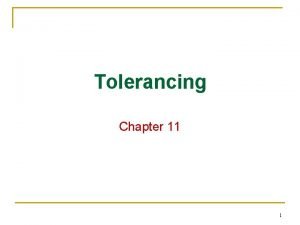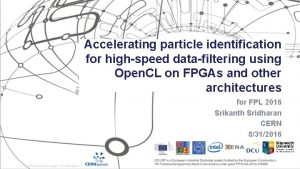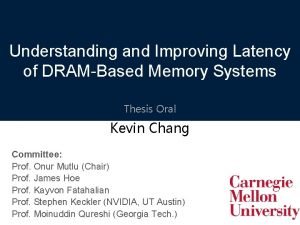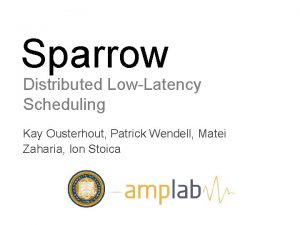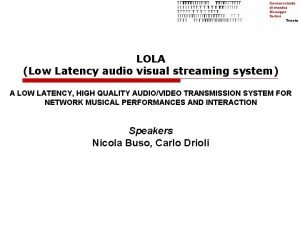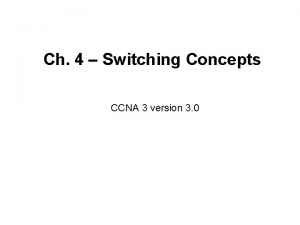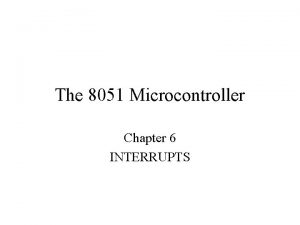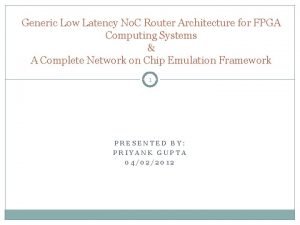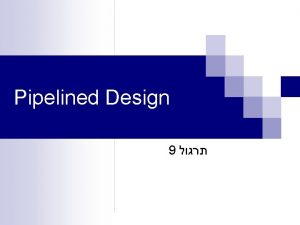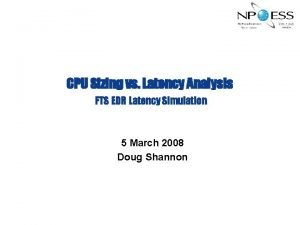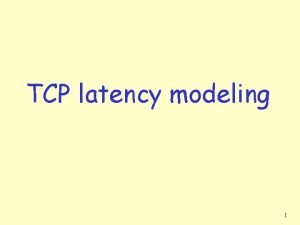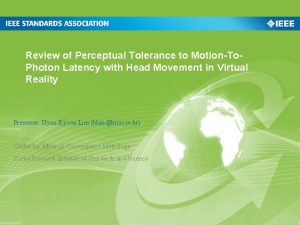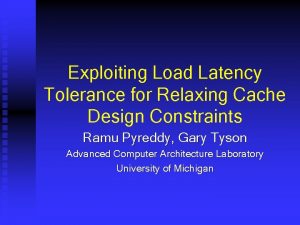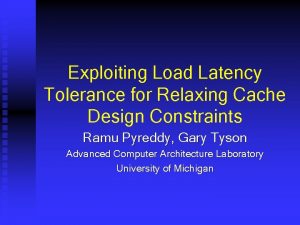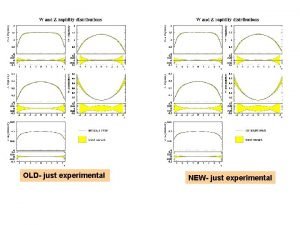Latency Tolerance what to do when it just


















- Slides: 18

Latency Tolerance: what to do when it just won’t go away CS 258, Spring 99 David E. Culler Computer Science Division U. C. Berkeley CS 258 S 99

Reducing Communication Cost • Reducing effective latency • Avoiding Latency • Tolerating Latency • communication latency vs. synchronization latency vs. instruction latency • sender initiated vs receiver initiated communication 10/27/2021 CS 258 S 99 2

Communication pipeline 10/27/2021 CS 258 S 99 3

Approached to Latency Tolerance • block data transfer – make individual transfers larger • precommunication – generate comm before point where it is actually needed • proceeding past an outstanding communication event – continue with independent work in same thread while event outstanding • multithreading - finding independent work – switch processor to another thread 10/27/2021 CS 258 S 99 4

Fundamental Requirements • • extra parallelism bandwidth storage sophisticated protocols 10/27/2021 CS 258 S 99 5

How much can you gain? • Overlaping computation with all communication – with one communication event at a time? • Overlapping communication with communication – let C be fraction of time in computation. . . • Let L be latency and r the run length of computation between messages, how many messages must be outstanding to hide L? • What limits outstanding messages – – overhead occupancy bandwidth network capacity? 10/27/2021 CS 258 S 99 6

Communication Pipeline Depth 10/27/2021 CS 258 S 99 7

Block Data Transfer • Message Passing – fragmention • Shared Address space – local coherence problem – global coherence problem 10/27/2021 CS 258 S 99 8

Benefits Under CPS Scaling 10/27/2021 CS 258 S 99 9

Proceeding Past Long Latency Events • MP – posted sends, recvs • SAS – write buffers and consistency models – non-blocking reads 10/27/2021 CS 258 S 99 10

Precommunication • Prefetching – HW vs SW • Non-blocking loads and speculative execution 10/27/2021 CS 258 S 99 11

Multithreading in SAS • Basic idea – multiple register sets in the processor – fast context switch • Approaches – switch on miss – switch on load – switch on cycle – hybrids » switch on notice » simultaneous multithreading 10/27/2021 CS 258 S 99 12

What is the gain? • let R be the run length between switches, C the switch cost and L the latency? • what’s the max proc utilization? • what the speedup as function of multithreading? • tolerating local latency vs remote 10/27/2021 CS 258 S 99 13

Latency/Volume Matched Networks • • K-ary d-cubes? Butterflies? Fat-trees? Sparse cubes? 10/27/2021 CS 258 S 99 14

What about synchronization latencies? 10/27/2021 CS 258 S 99 15

Burton Smith’s MT Architectures • Denelcor HEP • Horizon • Tera 10/27/2021 CS 258 S 99 16

Tera System Pipeline • • 64 -bit, 3 -way LIW 128 threads per proc 32 regs per thread 8 branch trarget regs ~16 deep inst pipe 70 cycle mem upto 8 concurrent mem refs per thread – look-ahead field limit – speculative loads/ poison regs 10/27/2021 • full/empty bits on every mem word CS 258 S 99 17

A perspective on Mem Hierarchies Global dram local dram sram P regs • Designing for the hard case has huge value! • Speedup due to multithreading is proportional to number of msgs outstanding • Each takes state – capacity of a given level limits the number (as does occupancy and frequency) – achieve more tolerance by discarding lower-level – huge opportunity cost • Putting it back in enhances ‘local’ performance and reduces frequency • Natural inherent limits on speedup 10/27/2021 CS 258 S 99 18
 Cellular and molecular immunology
Cellular and molecular immunology Unilateral tolerance and bilateral tolerance
Unilateral tolerance and bilateral tolerance Rewrite the final six lines of romeo and juliet
Rewrite the final six lines of romeo and juliet Mparticle latency
Mparticle latency Improve memory latency
Improve memory latency Herpes latency
Herpes latency Sparrow: distributed, low latency scheduling
Sparrow: distributed, low latency scheduling Lola low latency
Lola low latency Phallic stage of development
Phallic stage of development What is erogenous zone of oral stage
What is erogenous zone of oral stage Ndis.sys latency
Ndis.sys latency Latency moon
Latency moon Which switching method has the lowest level of latency?
Which switching method has the lowest level of latency? Fixation of anal stage
Fixation of anal stage Mnemonic for freud's stages
Mnemonic for freud's stages Hdfs latency
Hdfs latency 8051 interrupt structure
8051 interrupt structure Generic low latency
Generic low latency Planetside 2 server latency
Planetside 2 server latency

